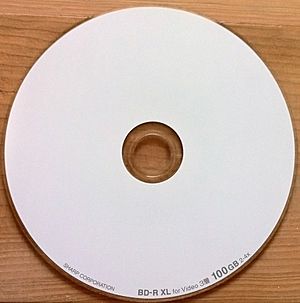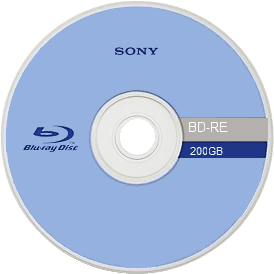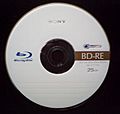Blu-ray Disc facts for kids
A Blu-ray Disc is a type of disc that stores a lot of information. It's similar to a DVD. Blu-ray discs are used for PlayStation 3 games and for watching high-definition (HD) movies. In the past, there was another disc type called HD DVD, but Blu-ray won what was called the format war. This means Blu-ray became the main standard.
A Blu-ray disc with two layers can hold up to 50 gigabytes (GB) of data. This is more than five times what a DVD can hold. It's also over 70 times more than a CD.
The Blu-ray disc was created by the Blu-ray Disc Association (BDA). This group includes companies that make electronics, computers, and media. They developed Blu-ray to record, rewrite, and play high-definition video. It also stores large amounts of data.
Older discs like DVDs use a red laser to read and write information. But Blu-ray discs use a blue-violet laser. This is where the name "Blu-ray" comes from!
Contents
Different Types of Blu-ray Discs
Mini Blu-ray Disc
The "Mini Blu-ray Disc" is a smaller version of the Blu-ray Disc. It's about 8 centimeters (3 inches) wide. A single-layer Mini Blu-ray Disc can store 7.8 GB of data. A dual-layer one can hold 15.6 GB. These small discs are like the MiniDVD and MiniCD. They are made for small camcorders and other recording devices. You can get versions that record once (BD-R) or rewrite many times (BD-RE).
Blu-ray Disc Recordable
"Blu-ray Disc recordable" means discs you can record on using a special player.
- BD-R discs can be written on only one time.
- BD-RE discs can be erased and recorded on many times.
Blu-ray discs can record data very fast, up to about 12 times their normal speed. If they spin too fast, like CDs or DVDs, the recording might not work well. Since 2007, the smaller 8 cm Mini Blu-ray Disc is also available as a BD-RE.
Companies like Pioneer and Mitsubishi helped create a type of BD-R called LTH. These discs are cheaper to make because they use materials similar to CD-R and DVD-R. In 2008, the first BD-R LTH discs were released. Soon after, the PlayStation 3 could use them with a software update.
BDXL Discs

The BDXL format allows for even bigger storage. These discs can hold 100 GB or 128 GB of data. Some BDXL discs can be written on only once. Others can be rewritten many times, holding up to 100 GB. This format was created in 2010. BDXL discs are designed for storing very large amounts of information.
Related Pages
- DVD
- HD DVD
- Compact disc (CD)
Images for kids
-
An early 4K Blu-ray release at Best Buy. A 4K Blu-ray Disc player was also released.
-
A Panasonic Blu-ray player DMP-BD60 (from late 2009) compatible with AVCHD
See also
 In Spanish: Disco Blu-ray para niños
In Spanish: Disco Blu-ray para niños






